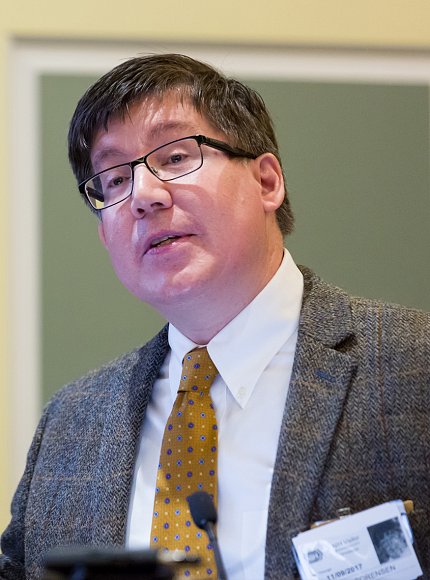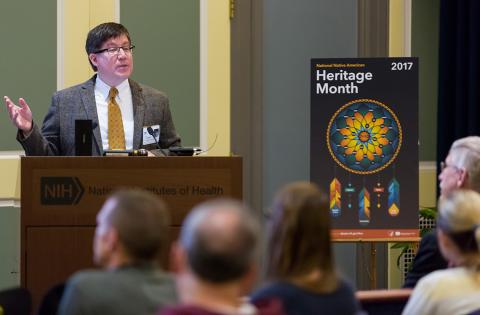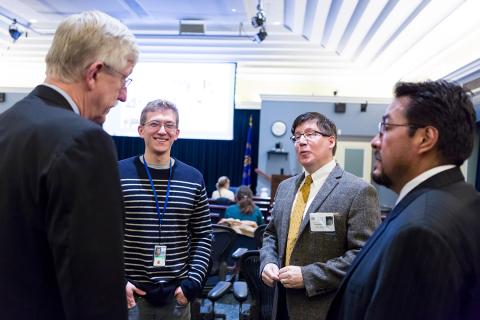Can We Synthesize Role Models?
Chemist Sorensen Urges More American Indians to Pursue Science

Photo: Daniel Soñé
As a young pre-med undergrad at Syracuse University, long distance runner Erik Sorensen was more interested in getting on the school’s Division 1 cross-country squad than he was in learning. It wasn’t until junior year that he found a calling he couldn’t ignore.
“When I took organic chemistry, my whole world changed,” he said. “I just fell in love—absolute love—with the subject of organic chemistry.”
Currently the Arthur Allan Patchett professor in organic chemistry at Princeton University, Sorensen gave a lecture Nov. 9 in honor of National Native American Heritage Month, sponsored by the Tribal Health Research Office (THRO) in NIH’s Division of Program Coordination, Planning and Strategic Initiatives.
“It’s hard for our people to relate to a subject like chemistry,” said Sorensen, a member of the Onondaga Nation in the Iroquois Confederacy. He spent his early childhood through age 7 living on the Onondaga reservation near Syracuse, N.Y.
“It’s a bit of a barrier,” he explained, “if you’re Native American and you grow up worshipping nature, you don’t naturally gravitate to a field like chemistry. But I did. I became inspired by [chemical] transformations as a young student. I much admired the way that nature can make the polycyclic triterpenes from acyclic chains of alkenes—the marvelous complexity generating structural transformations that are spontaneous.”
Role models and mentors also had a tremendous impact on young Sorensen. In his lecture, he traced his successful career path back to several strong familial influences, including his great grandmother, grandmother, sister and uncle—Leo Nolan III, an Indian Health Service retiree and member of the Mohawk Nation who was in the Wilson Hall audience to hear Sorensen’s talk.
“We can all point to inspiring teachers in our past who put us on a track that may have impacted in a positive way our career choice,” Sorensen said, naming Roger C. Hahn and James Kallmerten as professors who inspired him.

Photo: Daniel Soñé
It was most likely noted organic chemist Dr. K.C. Nicolaou—renowned for his research on vancomycin and taxol—who played the most monumental role in Sorensen’s decision to pursue science. A paper by Nicolaou, on how complex compounds found in nature can be synthesized, so fascinated Sorensen that he felt compelled to drop medicine as a major and take up a different scientific field.
“I responded instantly to the aesthetics of organic chemistry, the aesthetics of structural transformations—both naturally occurring and also structural transformations that chemists have developed,” Sorensen said. “I broke my mother’s heart. ‘What does a chemist do?’ she asked. She actually cried.”
Sorensen was determined, though, and his hard work was rewarded with a graduate post in the lab of Nicolaou, who eventually became Sorensen’s doctoral thesis advisor at the Scripps Research Institute and at the University of California, San Diego.
Now leading his own independent research group in the Frick Chemistry Laboratory at Princeton—he’s held grants from NCI, NIGMS and NIH’s National Research Service Award—Sorensen intends to parlay his passion for chemistry into recruitment of young people, endeavoring to lure more Native Americans and other members of underrepresented minority populations into science.
That made him the perfect choice to keynote NIH’s Native American Heritage Month observance, hosted by THRO director Dr. Dave Wilson, a member of the Navajo Nation. “Native Pride and Spirit,” this year’s theme, focuses on strongly linking the legacy of American Indians to the next generation of thought leaders, engineers and particularly, scientists.
Opening the event, NIH director Dr. Francis Collins recalled valuable lessons he experienced while overseeing the Human Genome Project.
In trying to decipher how “our own DNA instruction book could provide benefits to people across many different parts of this country and outside the country,” he noted, “I learned a lot by working with Native American communities, understanding the issues that are very important to them in terms of how this kind of information can be utilized for benefit or, at times, in ways that they were not happy about that we needed to learn from as well. So I’m delighted we have this chance now through [THRO] to create even more visible and ongoing focus on issues that are of interest to the American Indian and Alaska Native communities.”
Sorensen identified several cultural challenges to attracting and retaining promising Native American talent to STEM fields.

Photo: Daniel Soñé
“All of the Native students that I know are deeply connected to our families and to our cultures…and [do not immediately embrace] the idea of leaving our homes to go out into the world and pursue studies that are long and hard toward a degree in the sciences,” he pointed out. “It’s not obvious how that is going to improve our lives back at home. What good would a degree in chemistry do me back at home on the Nation?”
Sorensen said it’s up to American Indians, like himself, already working in the sciences, to reach back and offer other underrepresented groups a view of what’s at stake and the benefit of STEM careers.
“We need to improve our teaching, but we also need to diversify our professoriate,” Sorensen concluded. “This is a big issue that resonates strongly with me. When young underrepresented minority students look at the faculties of chemistry departments nationwide, they don’t see people who look like them. They see very few people with similar life experiences and cultural connections. We keep hiring new faculty who look an awful lot like the people we already have. There isn’t much diversity in chemistry departments…I’m a little bit pessimistic on this issue, but I think we can certainly strive to make these departments do better at increasing diversity...Role models are important and we all know that to be true.”
The full event is archived at https://videocast.nih.gov/summary.asp?Live=26435&bhcp=1.
